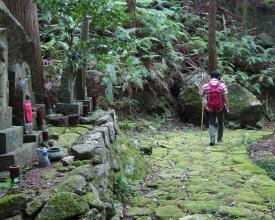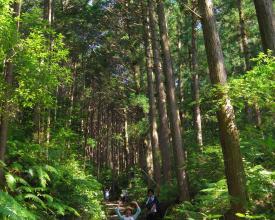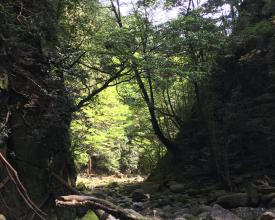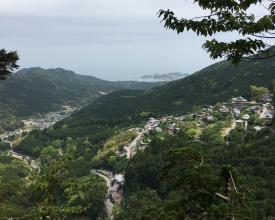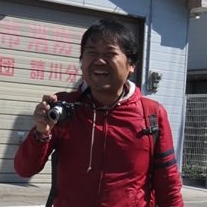
Intégration de la gestion religieuse et traditionnelle dans la gestion des sites sacrés et des chemins de pèlerinage du patrimoine mondial de la chaîne de montagnes Kii, Japon
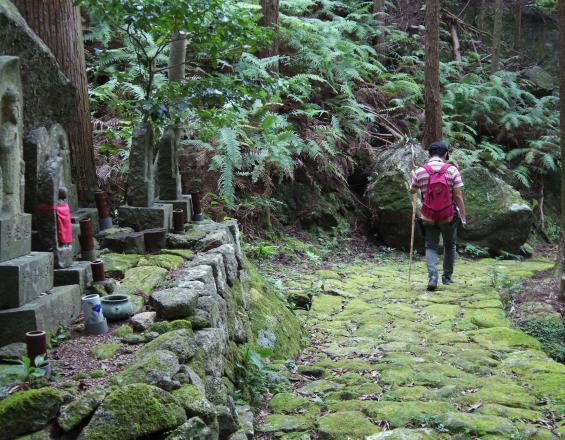
Les sites sacrés et les chemins de pèlerinage de la chaîne de montagnes Kii au Japon ont été inscrits en tant que paysage culturel sur la Liste du patrimoine mondial en 2004, sur la base des critères (ii), (iii), (iv) et (vi). Le bien inscrit comprend des parties du parc national de Yoshino-Kumano, aire protégée de catégorie II de l'UICN et le cœur de la réserve de biosphère de l'UNESCO du mont Odaigahara, du mont Omine et d'Osugidani, ainsi que des lieux de beauté pittoresque, des sites historiques, des trésors nationaux et des monuments naturels qui sont protégés en vertu de la loi japonaise sur la protection des biens culturels. Elle est composée des noyaux de trois des religions les plus importantes du Japon : Le shintoïsme à Kumano-Sanzan, le bouddhisme Shingon à Koyasan et le Shugendo à Yoshino et Omine, ainsi que les chemins de pèlerinage qui les relient. La gestion d'un bien aussi complexe, où les valeurs naturelles et culturelles et les systèmes de protection sont interdépendants, repose sur sa valeur sacrée et sur l'intendance permanente des communautés religieuses et locales présentes dans la région.
Contexte
Défis à relever
La conservation du paysage culturel des monts Kii représente un défi de gestion en raison de la complexité du bien : Situé sur trois préfectures adjacentes et contenant plusieurs niveaux de protection pour les diverses ressources naturelles et culturelles, il nécessite la coordination d'une variété de parties prenantes.
Ce bien contient trois montagnes sacrées représentatives des trois principales religions du Japon. La coordination des différents organismes religieux est un défi majeur.
Chacun des organismes religieux est responsable des forêts primaires et des autres forêts de sa région. Celles-ci doivent être entretenues et gérées en permanence. L'entretien des forêts secondaires entourant les forêts primaires, les sanctuaires religieux et les chemins de pèlerinage est tout aussi important.
Les chemins de pèlerinage, qui ne sont pas sous le contrôle de ces groupes religieux, peuvent rapidement être envahis par les mauvaises herbes et les arbres tombés s'ils ne sont pas entretenus, ce qui les rend inaccessibles aux pèlerins et aux touristes.
Emplacement
Traiter
Résumé du processus
La mise en place d'une structure de gouvernance transfrontalière pour le bien du patrimoine mondial (BB1) a permis la coopération entre les différents organismes religieux, qui restent autonomes dans la gestion de leurs lieux sacrés (BB2). Les forêts et les temples gérés par les organismes religieux sont reliés par les chemins de pèlerinage, qui sont conservés à la fois par le gouvernement et par les communautés locales, en raison de la grande variabilité de leur propriété. L'entretien de tous ces éléments naturels et culturels du bien est basé sur leur valeur spirituelle, non seulement pour les institutions religieuses responsables, mais aussi pour les communautés locales qui habitent ces zones. La tradition d'entretien des chemins de pèlerinage (BB4) et la conservation communautaire des forêts secondaires (BB3) s'inscrivent dans la tradition culturelle japonaise de gestion de la nature.
Blocs de construction
Structure de gouvernance transfrontalière pour le bien du patrimoine mondial
Outre le patrimoine culturel désigné en vertu de la loi sur la protection des biens culturels appliquée par l'Agence des affaires culturelles, le bien contient des zones conformes au parc national de Yoshino-Kumano dont l'administration est confiée au ministère de l'Environnement et aux trois préfectures qui y sont rattachées : Wakayama, Nara et Mie, et leurs autorités locales. Le Conseil des trois préfectures pour les sites sacrés et les chemins de pèlerinage de la chaîne montagneuse de Kii, inscrits au patrimoine mondial, a d'abord été créé pour poursuivre la proposition d'inscription sur la Liste du patrimoine mondial et, après l'inscription, il est chargé de coordonner les actions de conservation et d'élaborer le plan de gestion. Les gouverneurs des trois préfectures en sont les présidents et vice-présidents, tandis que les maires et les responsables de l'éducation des municipalités en sont les membres. L'Agence des affaires culturelles y participe en tant qu'observateur. La protection des biens culturels est assurée en collaboration avec le département de la protection des biens culturels et du développement régional de chaque préfecture et le responsable de la municipalité. En outre, le Conseil est conseillé par un comité scientifique composé d'experts de plusieurs domaines.
Facteurs favorables
Le vif intérêt des trois préfectures et du gouvernement pour l'inscription du paysage culturel des monts Kii sur la Liste du patrimoine mondial a permis d'établir un partenariat entre les préfectures et les institutions gouvernementales chargées de la conservation afin de développer et de poursuivre la proposition d'inscription.
Leçon apprise
Conformément aux recommandations du Comité du patrimoine mondial au moment de l'inscription, les trois préfectures ont formulé un plan global de gestion de la conservation et établi un système dans lequel les trois conseils préfectoraux prennent la direction de la conservation et de la gestion. Ce système a eu un impact majeur sur la manière dont plusieurs préfectures japonaises ont proposé l'inscription d'autres sites sur la Liste du patrimoine mondial et ont géré leur conservation, comme Fujisan, lieu sacré et source d'inspiration artistique (le mont Fuji).
Accorder une autonomie aux organismes religieux dans la gestion de leurs lieux sacrés (forêts et temples)
Tout au long du processus de désignation des lieux sacrés des monts Kii comme patrimoine culturel et patrimoine naturel (dans le cadre d'un parc national), puis de leur inclusion dans la réserve de biosphère, pour finalement faire partie du bien du patrimoine mondial, les organismes religieux se sont vus officiellement accorder leur protection et leur gestion selon les connaissances traditionnelles transmises depuis des siècles, fondées sur des croyances religieuses et des valeurs sacrées. Par exemple, en raison de leur caractère sacré, les forêts vierges ont été conservées avec des interdictions strictes d'abattage par les différentes communautés religieuses. Les paysages montagneux sont interprétés comme des "mandalas" matérialisés par les bouddhistes Shingon, et les pratiquants du Shugendo reproduisent des "mandalas" en effectuant des pèlerinages et en pratiquant leurs pratiques ascétiques dans ces environnements naturels. Pour les pèlerins, les monts Kii représentent le paradis sur terre. Un autre exemple est la forêt sacrée de Nachi qui a été désignée comme "monument naturel" en vertu de la loi sur la protection des biens culturels, et dont la gestion a été confiée au sanctuaire shintoïste de Kumano Nachi, dans le cadre de son lieu sacré. La cascade de Nachi est considérée comme sacrée. Cela signifie que les eaux sacrées ne peuvent être ni touchées ni détournées.
Facteurs favorables
- Pratiques culturelles persistantes, connaissances traditionnelles et locales fondées sur la croyance en la sacralité de la nature.
- La protection juridique prévue par la loi sur la protection des biens culturels et la loi sur les parcs naturels est conçue pour reléguer et maintenir la relation traditionnelle entre la nature et l'homme sans imposer de cadres incompatibles avec une protection fondée sur la religion.
Leçon apprise
- Le caractère sacré a protégé les forêts vierges des monts Kii pendant plus de 1 000 ans et continue de le faire. Permettre à l'intendance religieuse de continuer à pratiquer ses traditions de conservation des forêts facilite le processus de conservation.
- L'importance de la sauvegarde des connaissances traditionnelles et des valeurs spirituelles des populations locales pour la protection continue des forêts vierges.
Poursuite de la conservation communautaire traditionnelle des forêts secondaires
La plupart des zones forestières des montagnes de Kii ont été plantées parce que cette région est traditionnellement un lieu d'exploitation forestière. Les arbres sont abattus tous les 50 à 100 ans et, après l'abattage, les gens plantent de petits arbres. Cette stratégie d'exploitation forestière traditionnelle est appliquée depuis le XVIe siècle selon des techniques traditionnelles telles que la collecte de graines, la plantation, la densité de plantation, l'éclaircissement et l'abattage, en particulier dans le comté de Yoshino, dans la préfecture de Nara, où les cerises sont caractéristiques. La préfecture de Nara a également introduit une taxe pour la conservation de l'environnement forestier et travaille avec des volontaires et des organisations privées par l'intermédiaire de ses municipalités pour abattre les forêts abandonnées. Les forêts abandonnées ont été replantées avec des feuillus au lieu de conifères tels que le cèdre et le cyprès, qui conviennent à la sylviculture, et les forêts mixtes de conifères et de feuillus sont en train d'être converties en forêts qui ne subiront plus aucune intervention humaine à l'avenir. Parallèlement à la plantation et à l'exploitation traditionnelles des arbres, nous essayons de maintenir les forêts et le paysage forestier des monts Kii de manière durable.
Facteurs favorables
- Exploitation forestière traditionnelle pratiquée dans la région depuis des siècles et continuité de cette tradition
- Soutien du gouvernement et d'autres autorités compétentes pour poursuivre cette tradition
Leçon apprise
- Ces dernières années, le nombre de travailleurs forestiers a diminué en raison d'une réduction de la demande de bois, d'une augmentation des coûts et d'un manque de relève. Le nombre de forêts abandonnées a augmenté, ce qui a été la principale raison du contrôle de la densité de plantation. Cela a entraîné des changements dans l'écologie forestière, l'érosion du sol due à la pauvreté du sous-bois, favorisant les glissements de terrain, les inondations, les sécheresses et d'autres risques provoquant des catastrophes.
- La promotion récente des énergies renouvelables a conduit à la construction d'installations solaires et éoliennes. Cela a entraîné une déforestation à grande échelle, et l'on craint que cela n'affecte la préservation du site du patrimoine mondial. Il est nécessaire de mettre en place un système de collecte d'informations sur la construction de ces installations et de coordination préalable, comme la préparation de lignes directrices, afin d'assurer la coexistence avec le patrimoine mondial.
Conservation participative des chemins de pèlerinage
En fonction de leur emplacement, les chemins de pèlerinage sont la propriété de particuliers, de gouvernements locaux ou nationaux qui se chargent de leur entretien. Les habitants locaux et les organisations à but non lucratif (OBNL) participent également à la restauration, à la conservation et à l'entretien de certains chemins de pèlerinage. Par exemple, de nombreuses sociétés de préservation sont actives sur le chemin de pèlerinage d'Iseji, où elles mènent des activités de nettoyage quotidiennes sur les cols de montagne où subsistent d'anciennes routes. Elles collaborent également aux patrouilles après les typhons et les fortes pluies. Ces activités sont consignées dans le rapport et soumises au conseil préfectoral de l'éducation concerné par l'intermédiaire du conseil municipal de l'éducation concerné.
Facteurs favorables
- La culture japonaise met l'accent sur l'attention portée à l'espace public et au bénéfice de la communauté dans son ensemble, et soutient une forte identification à l'environnement et l'attention portée à celui-ci.
- Le soutien du gouvernement et d'autres agences pour faciliter la participation des citoyens aux activités de volontariat, telles que la collecte et la distribution de dons.
Leçon apprise
- Le gouvernement coopérera avec les citoyens qui lancent des activités bénévoles.
- Dans le bien du patrimoine mondial, certaines activités nécessitent une autorisation. C'est un point qui doit être confirmé à l'avance par les bénévoles et le gouvernement.
Impacts
1. Impacts sur l'environnement :
- Conservation efficace et continue des forêts primitives. Par exemple, la forêt primitive de Nachi est l'une des forêts de lauriers les plus représentatives de cette région, couvrant une superficie de 32 hectares. C'est une forêt précieuse non seulement en raison de la couche dense de grands arbres tels que le cyprès japonais (hinoki-Chamaecyparisobtusa), le chinquapin japonais (tsuburaji-Castanopsiscuspidata) et le chêne bleu japonais (urajirogashi- Arhopala japonica ou Quercus salicina), mais aussi en raison de l'abondance des plantes du sol de la forêt telles que les fougères et les plantes grimpantes. Un autre exemple est la forêt vierge de Bukkyogatake, l'un des plus hauts sommets des monts Omine, d'une superficie de 9 hectares, qui est composée de conifères à feuilles persistantes tels que la forêt de Veitch d'origine subalpine.
2. Impacts économiques et environnementaux :
- Utilisation durable des forêts secondaires
- Développement durable du tourisme
3. Impacts sociaux :
- Cohésion communautaire
- Sauvegarde des connaissances traditionnelles
- Sauvegarde des pratiques culturelles et religieuses locales et traditionnelles
Bénéficiaires
Communautés locales, fidèles de chaque religion, pèlerins, visiteurs
Objectifs de développement durable
Histoire

En tant que fonctionnaire de la préfecture, je participe à la préservation de ce site du patrimoine mondial. L'un des moments les plus inoubliables de ma carrière est la catastrophe du typhon de 2011.
Le 4 septembre, un typhon a frappé la région : Les voies ferrées ont été détruites, les routes nationales ont été coupées et des glissements de terrain se sont produits dans de nombreuses parties des monts Kii. Les dommages causés aux chemins de pèlerinage ont été particulièrement graves.
Le 7 septembre, nous avons reçu un appel téléphonique d'un fonctionnaire municipal. Il nous a signalé des dégâts sur le site du patrimoine mondial. Au milieu de la catastrophe, ils continuaient à faire des rondes pour évaluer les dégâts. Des bénévoles locaux faisaient le tour de la route de pèlerinage. Ensemble, ils ont envoyé les informations au bureau du gouvernement préfectoral, situé à 100 km de là.
Le 8 septembre, la route nationale a été ouverte à la circulation. Je me suis rendu sur le site du patrimoine mondial. Des bénévoles avaient commencé à nettoyer le chemin de pèlerinage et à enlever les arbres tombés.
Un énorme arbre, symbole de l'île sacrée dans la rivière, a également été emporté par les eaux. Le propriétaire, le prêtre du sanctuaire, a proposé de le restaurer en plantant des arbres.
Les forêts secondaires entourant le chemin de pèlerinage, qui appartiennent à la zone tampon du bien du patrimoine mondial et qui sont entretenues par les propriétaires et l'association forestière, ont également été endommagées. Ils ont proposé d'enlever les arbres tombés et de planter de jeunes arbres.
Entre-temps, j'ai pu négocier avec le gouvernement national pour qu'il finance le plan de restauration des grandes zones touchées.
Au bout d'un certain temps, le fonctionnaire de la mairie qui m'avait appelé en premier m'a dit : "J'aimerais beaucoup étudier le concept de patrimoine mondial. J'aimerais pouvoir mieux protéger le site du patrimoine mondial". J'en ai parlé aux collègues avec lesquels nous discutions de la restauration du site, et nous avons décidé d'organiser un atelier réunissant des personnes des trois préfectures, du gouvernement municipal et du gouvernement national. Ces ateliers se poursuivent 10 ans après.
Les "sites sacrés et chemins de pèlerinage de la chaîne montagneuse de Kii" sont protégés grâce aux efforts de nombreuses personnes différentes : les trois préfectures, les municipalités, les bénévoles, les chefs religieux et les forestiers. La protection est assurée par le dialogue, l'apprentissage mutuel et la coopération entre les parties. Nous ne devons pas oublier les efforts de toutes ces personnes. (Fumihiko Ito, préfecture de Mie)

